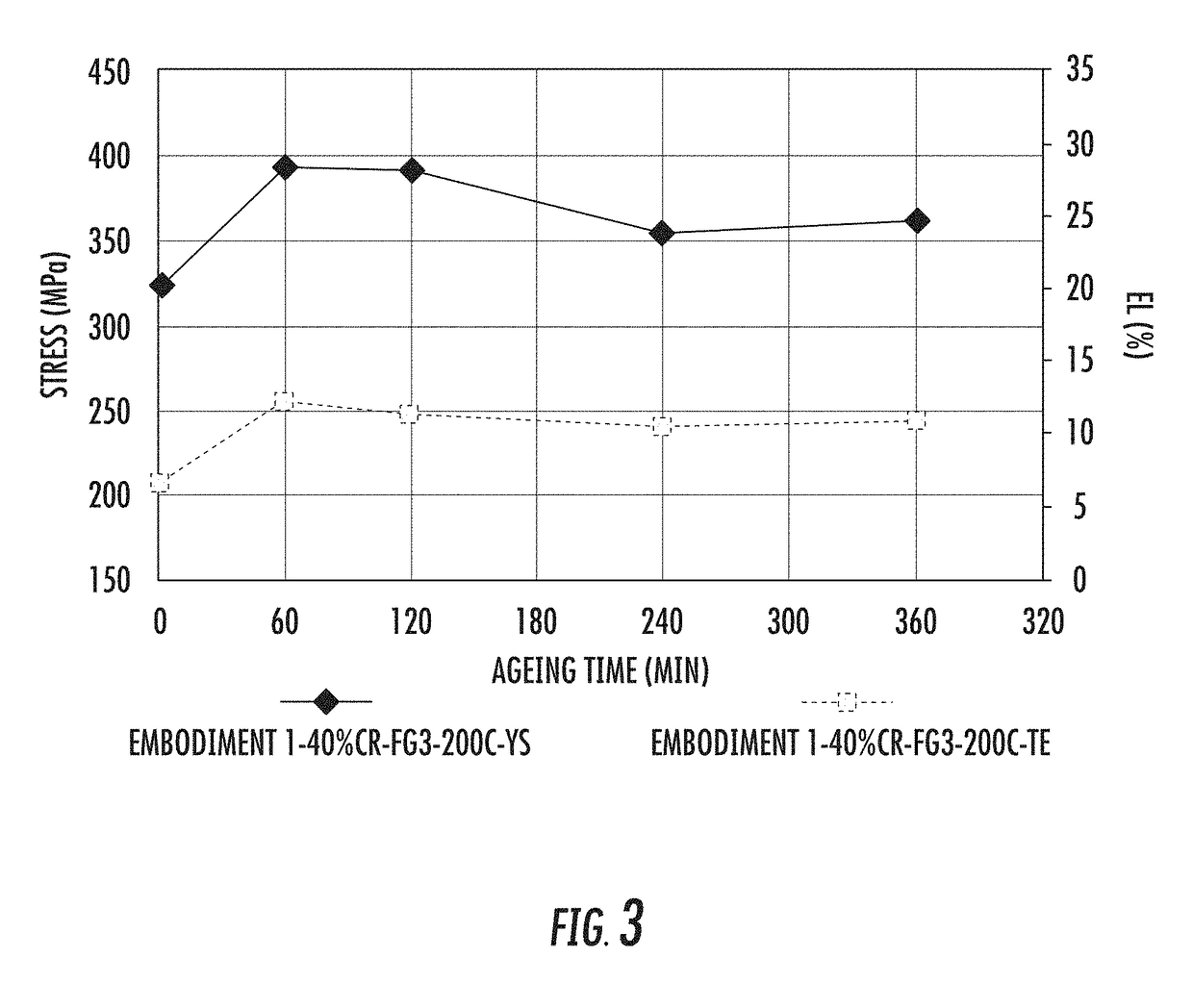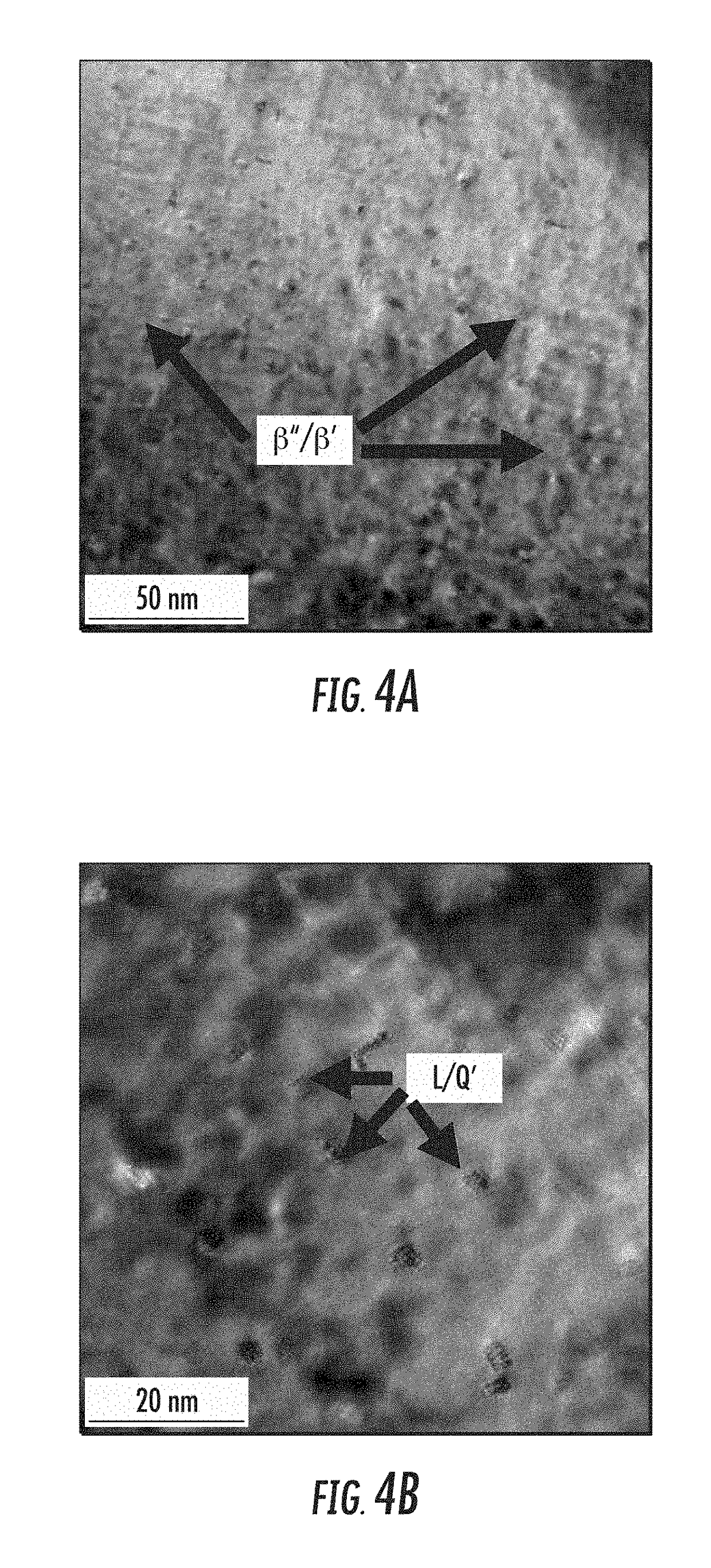High strength 6xxx aluminum alloys and methods of making the same
a technology of aluminum alloys and high strength, applied in the field of new high strength 6xxx aluminum alloys, can solve the problems of increasing vehicle weight and fuel efficiency of steel components, and achieve the effect of reducing fuel efficiency and increasing vehicle weigh
- Summary
- Abstract
- Description
- Claims
- Application Information
AI Technical Summary
Benefits of technology
Problems solved by technology
Method used
Image
Examples
example 1
[0107]Exemplary alloys having the compositions listed in Table 1 were produced according to the following exemplary methods: the as-cast aluminum alloy ingots were homogenized at a temperature between about 520° C. and about 580° C. for at least 12 hours; the homogenized ingots were then hot rolled to an intermediate gauge comprising 16 passes through a hot roll mill, wherein the ingots entered the hot roll mill at a temperature between about 500° C. and about 540° C. and exited the hot roll mill at a temperature between about 300° C. and 400° C.; the intermediate gauge aluminum alloys were then optionally cold rolled to aluminum alloy sheets having a first gauge between about 2 mm and about 4 mm; the aluminum alloy sheets were solutionized at a temperature between about 520° C. and 590° C.; the sheets were quenched, either with water and / or air; the sheets were optionally cold rolled to a final gauge between about 1 mm and about 3 mm (i.e., the sheets were subjected to a cold reduc...
example 2
[0120]Embodiments 1, 2-1, and 2-2 were solution heat treated as described previously. This was followed by about 20% CW to a final gauge of about 7 mm. The samples were subsequently artificially aged at 200° C. for various times. The results are summarized in FIG. 19. The disclosed alloys, after applying 20% CW followed by aging treatment have a minimum yield strength of 360 MPa and a minimum total % EL of 20% and or greater. See FIGS. 19, 20A and 20B.
example 3
[0121]Embodiments 1, 2-1, and 2-2 were subject to a conventional artificial aging treatment followed by about 20% to about 40% CW. The cold work was applied to samples having an initial thickness of about 11 mm and about 9 mm resulting in final gauge of 7 mm and 3 mm. The results are summarized for Embodiment 1 in FIG. 21.
[0122]As demonstrated in this example, Embodiment 1 has a minimum yield strength of 330 MPa in T6 condition with a minimum total elongation of 20%. By combining the composition and method of manufacture where about 20% CW to less than 25% CW is applied after solution heat treatment and quench, and prior to aging, the minimum yield strength is about 360 MPa with a minimum total elongation of about 20%. The variant displayed a minimum yield strength after 40% - 45% CW of 390 MPa with a minimum total elongation of 15%.
PUM
| Property | Measurement | Unit |
|---|---|---|
| Temperature | aaaaa | aaaaa |
| Temperature | aaaaa | aaaaa |
| Temperature | aaaaa | aaaaa |
Abstract
Description
Claims
Application Information
 Login to View More
Login to View More - R&D
- Intellectual Property
- Life Sciences
- Materials
- Tech Scout
- Unparalleled Data Quality
- Higher Quality Content
- 60% Fewer Hallucinations
Browse by: Latest US Patents, China's latest patents, Technical Efficacy Thesaurus, Application Domain, Technology Topic, Popular Technical Reports.
© 2025 PatSnap. All rights reserved.Legal|Privacy policy|Modern Slavery Act Transparency Statement|Sitemap|About US| Contact US: help@patsnap.com



